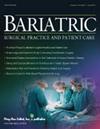Interest of Spinal Analgesia in Bariatric Surgery
IF 0.3
4区 医学
Q4 NURSING
引用次数: 0
Abstract
Introduction: Enhanced rehabilitation after surgery (ERAS) should be applied to bariatric surgery. Multimodal analgesia is one of the pillars of ERAS, of which spinal analgesia (SA) is a part. The interest of SA in bariatric surgery is poorly described, yet it can be performed easily even in obese patients, reducing postoperative pain, opioid consumption, and hospitalization time. Materials and Methods: This is a retrospective and comparative study; the objective was to study the feasibility and interest of SA combining 100 μg of morphine and 150 μg of clonidine in bariatric surgery during the first postoperative day. Results: Thirty-six patients were included: 29 patients (81%) benefited from SA (group SA) and 7 benefited from standard analgesia (group S). SA was linked to a decrease in postoperative morphine consumption (odds ratio −2.551, 95% confidence interval [−5.212 to −0.570], p = 0.016). The rate of acute high blood pressure was significantly higher in group S (p = 0.05). There was no difference between the two groups in the occurrence of side effects. Conclusions: SA with morphine and clonidine improves postoperative analgesia. We recommend 0.1 mg as the standard dose. The use of clonidine could make it possible to limit the dose of morphine injected and reduce the postoperative hypertensive risk. french registration: ANSM—RCB ID: 2018-A01310-55.脊柱镇痛在减肥手术中的作用
手术后增强康复(ERAS)应应用于减肥手术。多模态镇痛是ERAS的支柱之一,其中脊髓镇痛(SA)是其中的一部分。SA在减肥手术中的应用鲜有报道,但即使在肥胖患者中也可以很容易地进行,减少了术后疼痛、阿片类药物的消耗和住院时间。材料与方法:回顾性比较研究;目的探讨100 μg吗啡和150 μg可乐定联合应用于减肥手术术后第一天的可行性和趣味性。结果:纳入36例患者:29例(81%)患者受益于SA (SA组),7例受益于标准镇痛(S组)。SA与术后吗啡用量减少有关(优势比为- 2.551,95%可信区间[- 5.212至- 0.570],p = 0.016)。S组急性高血压发生率显著高于对照组(p = 0.05)。两组的副作用发生率无差异。结论:吗啡与可乐定联合用药可改善术后镇痛。我们推荐0.1毫克作为标准剂量。使用可乐定可以限制吗啡的注射剂量,降低术后高血压的风险。法国注册:ANSM-RCB ID: 2018-A01310-55。
本文章由计算机程序翻译,如有差异,请以英文原文为准。
求助全文
约1分钟内获得全文
求助全文
来源期刊
CiteScore
0.80
自引率
0.00%
发文量
36
期刊介绍:
Bariatric Surgical Practice and Patient Care is the essential peer-reviewed journal delivering clinical best practices and quality updates for achieving optimal bariatric surgical outcomes.
Bariatric Surgical Practice and Patient Care coverage includes:
Quality outcomes measurement and reporting
Process innovations and care delivery
Short- and long-term surgical complications
Pre-surgical diagnosis and consultation
Pre-op, peri-op, and post-op standards of practice
Patient access
Patient safety issues
Nutritional and dietary support
Bariatric surgical emergencies
Best practices and current standards for bariatric surgery
Culture and ethics
Body contouring and reconstructive surgery
Bariatric teamwork and communication.

 求助内容:
求助内容: 应助结果提醒方式:
应助结果提醒方式:


